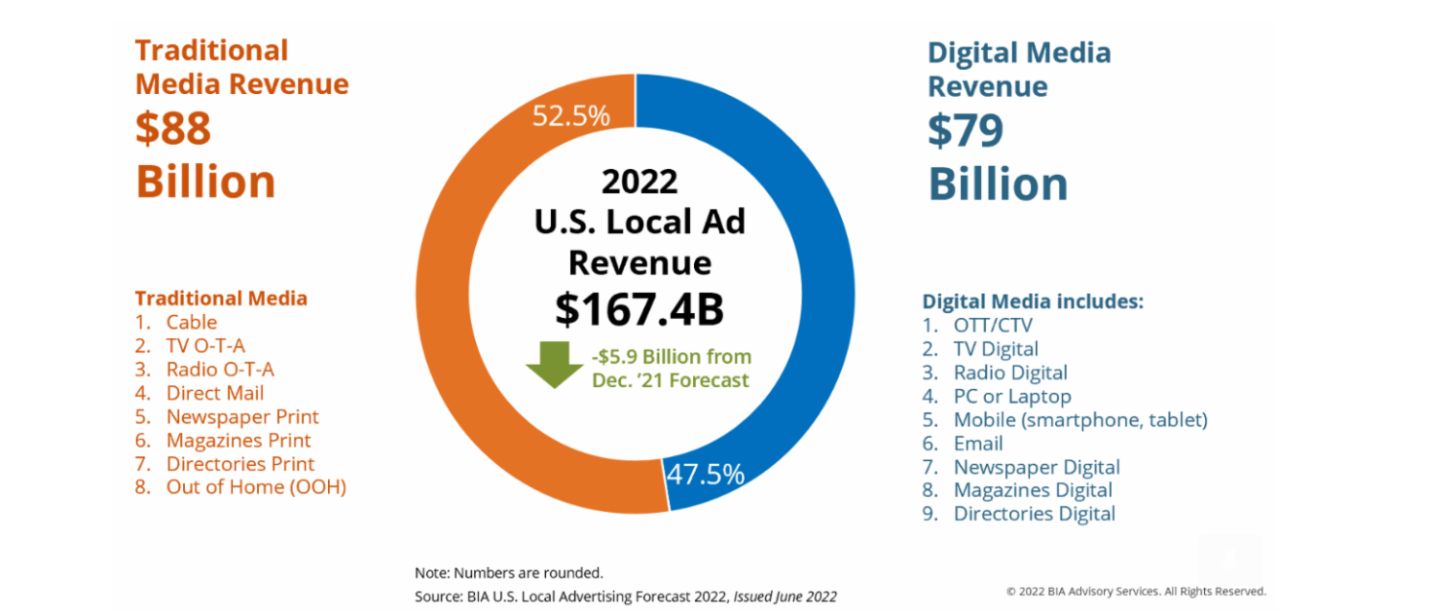BIA Decreases 2022 Estimates for U.S. Local Advertising Revenue to $167.4B Indicating Headwinds for the Overall Local Advertising Marketplace
By
Research Associate and Content Manager, Sheridan LePlatt
BIA Advisory Services has decreased its 2022 U.S. Local Advertising Forecast estimate to $167.4 billion, from its original estimate of $173.3 billion issued in December 2021.
Headwinds from overseas conflicts, continuing supply chain issues, and deep cuts in ad spending from large verticals like automotive precipitated the reduction.
Overall, BIA is decreasing digital estimates slightly from the original 2022 forecast due to mobile facing headwinds amid new privacy measures on iPhones.
BIA Advisory Services has decreased its 2022 U.S. Local Advertising Forecast estimate to $167.4 billion, from its original estimate of $173.3 billion issued in December 2021. Headwinds from overseas conflicts, continuing supply chain issues, and deep cuts in ad spending from large verticals like automotive precipitated the reduction. Positives for the ad market still include an anticipated strong political ad year, the expansion of online gambling local advertising, and consumer spending on leisure and recreational activities. The updated local advertising forecast for 16 media and 96 sub-verticals is now available in the BIA ADVantage™ platform and local radio and television revenue has been updated in the MEDIA Access Pro™ database.
“The year didn’t start as strong as we had anticipated, making for a difficult first two quarters as some expected advertising spend started to retract,” said Mark Fratrik, SVP and Chief Economist, BIA Advisory Services. “On the one hand, personal income continues to rise, but the cost of consumer goods, rising gas prices, and inflation are having a major impact and we believe that will influence how advertisers will choose to use their ad dollars in the coming months. All of that must be weighed against what we see as positives for local advertising this year.”
The latest forecast estimate still gives traditional media ad revenue a slight advantage over digital at 52.5 percent of the ad spend ($87.9B), while digital media will get 47.5 percent of the ad spend at $79.5B. Overall, BIA is decreasing digital estimates slightly from the original 2022 forecast due to mobile facing headwinds amid new privacy measures on iPhones. Additionally, there has been slower than anticipated growth. Even as both digital channels continue to grow, it’s at a reduced pace than originally expected.
Key indicators for media channels in 2022 include the following:
The top three paid media channels for 2022 include Direct Mail ($34B), Mobile ($32B), and PC/Laptop ($30B).
Over-the-top (OTT) is still slated to be the fastest-growing (57.4 percent this year).
Significant growth is expected in TV OTA (+30.3 percent), TV Digital (+18.3 percent) and Radio Digital (+14.5 percent).
When examining the biggest changes in the top spending sub-verticals, the updated 2022 forecast reveals key shifts that reflect the supply chain situation, trends in consumer spending and a strong political year. From original 2022 estimates, top changes in the forecast reveal:
Tier 1 - Automotive Manufacturers (OEMs) has been adjusted down -17.6 percent to $3.9 billion (was $4.7 billion). Overall, for the entire automotive industry, BIA lowered the updated ad estimates by $1.4B for a total of $12.4B. That still indicates some growth from 2021, 5.5 percent, but significantly down from original estimates.
Leisure areas like Airport, Cruises, and Other Travel; Fitness and Recreational Sports Centers; and Museums, Historical Sites, and other venues are all experiencing significant growth in ad spending from last year to this year. Pent-up demand for travel and entertainment are driving growth in these areas but may be tempered by late summer due to inflation and other economic concerns.
Local political advertising spending was raised to $8.6B with local television getting a large share of the spend.
BIA’s VP of Forecasting & Analysis, Nicole Ovadia, offered her assessment of the forecast saying, “We are seeing the economy play out in local advertising. For instance, people saved money during the pandemic and now, are enjoying different areas in the leisure and recreational verticals. People are spending on vacations and activities, and even going back to the gym. In all these areas, including politics, we increased local advertising expectations. For businesses that have a direct reliance on supply chains, we have lowered expectations and will continue to monitor the situation throughout the summer fully expecting we may have to revise our estimates because the economy is in such a state of flux.”
To read more, please visit: http://www.biakelsey.com


